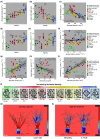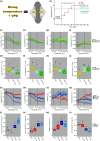The influences of stomatal size and density on rice abiotic stress resilience
- PMID: 36630602
- PMCID: PMC10952745
- DOI: 10.1111/nph.18704
The influences of stomatal size and density on rice abiotic stress resilience
Abstract
A warming climate coupled with reductions in water availability and rising salinity are increasingly affecting rice (Oryza sativa) yields. Elevated temperatures combined with vapour pressure deficit (VPD) rises are causing stomatal closure, further reducing plant productivity and cooling. It is unclear what stomatal size (SS) and stomatal density (SD) will best suit all these environmental extremes. To understand how stomatal differences contribute to rice abiotic stress resilience, we screened the stomatal characteristics of 72 traditionally bred varieties. We found significant variation in SS, SD and calculated anatomical maximal stomatal conductance (gsmax ) but did not identify any varieties with SD and gsmax as low as transgenic OsEPF1oe plants. Traditionally bred varieties with high SD and small SS (resulting in higher gsmax ) typically had lower biomasses, and these plants were more resilient to drought than low SD and large SS plants, which were physically larger. None of the varieties assessed were as resilient to drought or salinity as low SD OsEPF1oe transgenic plants. High SD and small SS rice displayed faster stomatal closure during increasing temperature and VPD, but photosynthesis and plant cooling were reduced. Compromises will be required when choosing rice SS and SD to tackle multiple future environmental stresses.
Keywords: climate change; drought; plant water-use; rice; salinity; stomata; temperature; vapour pressure deficit (VPD).
© 2023 The Authors. New Phytologist © 2023 New Phytologist Foundation.
Conflict of interest statement
None declared.
Figures






References
-
- Bates D, Machler M, Bolker B, Walker S. 2015. Fitting linear mixed‐effects models using lme4. Journal of Statistical Software 67: 1–48.
-
- Bouman B. 2009. How much water does rice use? Rice today. Manilla, Philippines: IRRI, 29.
Publication types
MeSH terms
Substances
Grants and funding
LinkOut - more resources
Full Text Sources

